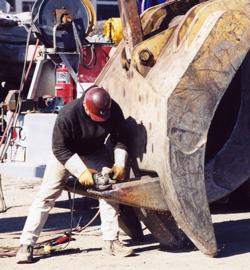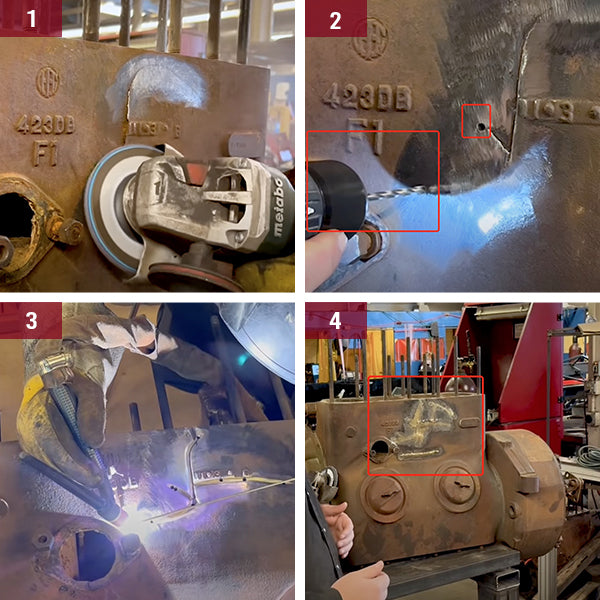Common Welding Repair Work Issues and Just How to Address Them Efficiently
Welding repairs frequently come across a range of concerns that can threaten the stability of the last item. Usual issues consist of insufficient infiltration, porosity, and imbalance, to name a few. Each problem provides one-of-a-kind difficulties that call for certain approaches for resolution. Comprehending these concerns is essential for welders aiming to improve their end results and skills. This discussion will certainly explore these typical welding fixing issues and efficient methods to resolve them.
Inadequate Penetration
Poor penetration takes place when the weld steel stops working to fully fuse with the base product, resulting in weak joints and prospective architectural failures. This concern usually comes from insufficient heat input, inaccurate electrode angle, or inappropriate welding rate. Welders might come across poor penetration as a result of a miscalculation of the necessary criteria for a details product density or type. Furthermore, contamination on the base material's surface area can hinder reliable bonding, intensifying the problem. To deal with inadequate penetration, welders must ensure appropriate setups on their devices and maintain a tidy job surface. Routine assessment of welds is recommended to recognize any kind of deficiencies early, enabling for prompt improvements and the prevention of endangered architectural honesty in welded assemblies.
Porosity
Porosity is a common defect in bonded joints that manifests as little gas bubbles trapped within the weld metal. This defect can jeopardize the integrity of the weld, resulting in decreased strength and potential failing under stress and anxiety. Montana Mobile Welding and Repair Belgrade Welding. Porosity typically arises from contamination, dampness, or incorrect welding methods, which allow gases to escape into the liquified weld pool. To address porosity, welders must assure correct surface area preparation, maintain a tidy working environment, and utilize suitable welding criteria. In addition, picking the best filler product and protecting gas can mitigate gas entrapment. Normal evaluation and testing of welds can assist recognize porosity early, ensuring timely corrective activities are taken, therefore maintaining the top quality and dependability of the bonded framework
Imbalance
Misalignment in welding can arise from numerous elements, consisting of improper configuration and thermal expansion. Recognizing the origin is essential for efficient resolution. Numerous correction strategies are available to straighten components and guarantee structural honesty.
Causes of Imbalance
Welding imbalance usually stems from a range of underlying problems that can jeopardize structural honesty. One key reason is incorrect fit-up of components before welding, which can bring about voids and unequal surfaces. Variations in thermal development during the welding process can also cause distortion, particularly if the materials being signed up with have different coefficients of development. Additionally, poor securing and fixturing may stop working to hold components firmly in location, leading to activity during welding. Inadequately conserved equipment, including welding machines and devices, may introduce incongruities in the weld bead, additional adding to misalignment. Ultimately, operator mistake, originating from insufficient training or experience, can likewise play a substantial role in creating misaligned welds.
Correction Techniques Readily Available
Attending to imbalance efficiently needs a combination of corrective methods tailored to the details issues handy. One usual approach is the usage of components or jigs to hold components in the proper setting throughout welding, guaranteeing consistent positioning. In addition, pre-heating the materials can help minimize distortion and enhance fit-up. For substantial misalignment, mechanical realignment strategies, such as making use of hydraulic jacks or clamps, can be utilized to remedy the position prior to welding. Post-weld warm treatment may likewise be essential to soothe tensions caused by misalignment. Finally, cautious evaluation and adjustment throughout the setup phase can prevent misalignment issues from coming to be significant issues, promoting a smoother welding process and boosting total architectural integrity.
Distortion
Distortion is a typical difficulty in welding that can emerge from various aspects, including irregular cooling and heating. Comprehending the reasons for distortion is essential for applying effective prevention methods. Addressing this concern not only enhances architectural honesty however also boosts the total top quality of the weld.
Root causes of Distortion
When subjected to the intense heat of welding, products commonly go through changes that can result in distortion. This sensation mainly occurs from thermal expansion and tightening throughout the welding process. As the weld location warms up, the product expands; upon air conditioning, it contracts, which can produce inner stress and anxieties. In addition, irregular home heating across a workpiece can exacerbate these stresses, leading to warping or bending. The kind of product also plays a considerable role; metals with differing thermal conductivity and coefficients of growth may react differently, bring about unpredictable distortions. Bad joint layout and insufficient fixturing can add to misalignment throughout welding, increasing the likelihood of distortion. Understanding these causes is important for efficient welding fixing and avoidance approaches.
Avoidance Techniques
Reliable avoidance techniques for distortion throughout welding focus on managing heat input and ensuring proper joint style. Preserving a regular warm input aids to decrease thermal development and contraction, which can cause distortion. Utilizing techniques such as preheating the work surface can also reduce the temperature gradient, advertising uniform home heating. Furthermore, selecting proper joint styles, such as T-joints or lap joints, can improve stability and decrease stress and anxiety concentrations. Executing appropriate fixturing to protect the work surfaces in place even more aids in keeping placement during the welding procedure. Ultimately, staggered welding soldering copper wire series can distribute heat extra equally, stopping localized distortion. By using these strategies, welders can significantly lower the possibility of distortion and enhance the total high quality of their welds.
Cracking
Splitting is a typical concern run into in welding repair services, typically resulting from various factors such as incorrect air conditioning rates, product choice, or insufficient joint preparation. The occurrence of cracks can significantly compromise the stability of the weld, bring about possible failings during operation. To address this concern, welders have to first assess the source, making certain that materials are compatible and properly chosen for the specific application. Additionally, regulating the cooling rate throughout the welding procedure is essential; fast air conditioning can cause stress and result in splitting. Appropriate joint style and preparation additionally contribute to reducing the threat. Carrying out these methods can improve weld quality and durability, inevitably reducing the likelihood of splitting in completed weldments.

Insufficient Blend
A significant problem in welding fixings is insufficient fusion, which occurs when the weld metal does not sufficiently bond with the base material or previous weld passes - Montana Mobile Welding and Repair Belgrade Welding. This flaw can cause weak points in the joint, potentially jeopardizing the stability of the bonded structure. Factors adding to insufficient fusion include not enough warmth input, incorrect welding method, and contamination of the surfaces being joined. To address this problem effectively, welders ought to guarantee correct pre-weld cleaning and surface area preparation, as well as readjust their welding specifications to achieve ample penetration and combination. Routine evaluation during the welding procedure can additionally assist recognize insufficient combination early, enabling timely rehabilitative measures to enhance the total quality of the weld
Overheating
While welding repairs can boost architectural honesty, overheating presents a considerable challenge that can bring about material deterioration. Extreme warm during welding can change the mechanical residential properties of metals, resulting in decreased toughness, raised brittleness, and warping. This sensation is specifically critical in high-stress applications where structural reliability is critical. Recognizing getting too hot can entail aesthetic evaluations for staining or distortion, along with keeping an eye on temperature level during the welding process. To reduce the threats related to overheating, welders need to use ideal strategies, such as managing warm input, readjusting travel speed, and utilizing ideal filler products. In addition, applying pre- and post-weld warm treatments can assist bring back product residential properties and enhance the overall high quality of the repair, making sure long-lasting performance and safety and security.
Regularly Asked Concerns
What Are the Common Signs of a Welding Problem?

Just How Can I Evaluate My Welds for Quality?
To test welds for top quality, one can utilize visual assessments, ultrasonic testing, and radiographic techniques. their explanation Each strategy ensures architectural honesty, identifies problems, and validates adherence to specified requirements, inevitably improving the dependability of the welded joints.
What Safety Preventative Measures Should I Take While Welding?
When welding, one must prioritize safety by using ideal personal safety tools, ensuring correct ventilation, safeguarding combustible products away, keeping a tidy office, and understanding surroundings to avoid injuries and accidents.
Can I Repair a Weld Without Redoing the Entire Joint?
Fixing a weld without renovating the entire joint is feasible, depending on the damage (Belgrade Fabrication). Methods such as grinding, adding filler product, or utilizing a welding procedure can successfully resolve specific imperfections while protecting the bordering structure
What Devices Are Crucial for Efficient Welding Repair Works?
Essential devices for efficient welding repair work include a welding maker, cord brush, mill, safety gear, clamps, and filler products. Each tool plays an essential duty in making sure quality and safety and security during the repair work process. Porosity typically arises from contamination, wetness, or improper welding strategies, which enable gases to get away into the molten weld pool. Badly conserved devices, including welding devices my company and devices, might introduce inconsistencies in the weld grain, further contributing to imbalance. When subjected to the intense heat of welding, materials usually go through adjustments that can lead to distortion. Breaking is a common problem come across in welding repair work, often resulting from numerous variables such as incorrect cooling rates, product option, or inadequate joint preparation. A considerable problem in welding repairs is incomplete fusion, which takes place when the weld steel does not adequately bond with the base product or previous weld passes.
Comments on “Immediate responses to weld misalignment in Montana Mobile Welding and Repair Fabrication”